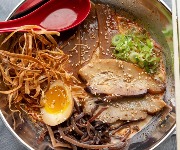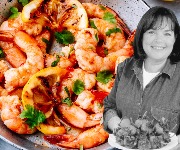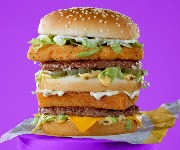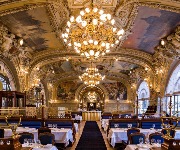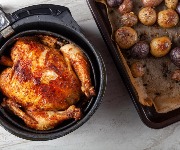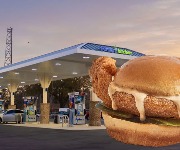Will you join in the bubble tea craze?

Who would have thought that tea with tapioca would ever become trendy?
Like juice bars and coffee chains in the 1990s, bubble tea shops are now popping up all over the UK.
It’s not a brand new phenomenon – the drink has been available here for at least a decade – but whereas before it was confined mainly to Chinatown and aimed at South East Asian students, recent openings like Chaboba in Camden and Bubbleology in Soho have brought bubble tea into the mainstream.
What is bubble tea?
It’s a flavoured, tea-infused drink, containing tapioca pearls (‘bubbles’) that can be sucked up through over-sized straws. Normally served cold, the drink comes in two main varieties: bubble milk tea and bubble fruit tea.
The milk-based variety is made from milk combined with brewed tea, flavourings and tapioca, whereas in the fruit-based version, the milk is replaced by fruit and crushed ice. An enormous choice of flavours is available, ranging from kumquat and taro, to watermelon and lavender.
More a snack or dessert than a drink in the conventional sense, bubble tea is known by dozens of similar names such as pearl tea or boba tea – ‘boba’ being a Chinese slang for ‘breasts’ and Taiwanese for ‘large-breasted movie star.’ The word alludes to the shape and texture of tapioca pearls, similar to the female breast.
There are at least half a dozen theories about who invented the drink – perhaps the most credible being that it was created at the Chun Shui Tang teahouse in Taichung in central Taiwan in the 1980s. Its popularity spread rapidly from Taiwan – where there are now around 8,000 bubble tea shops – to the whole of Southeast Asia, Canada, USA and, more recently, Latin America, the Middle East and the UK.
The founder of Bubbleology, Assad Khan, says of bubble tea that it’s “unique, and comes in so many different flavours that there’s something for everyone. Also, I think everyone just loves how quirky it is. Not every drink has delicious chewy tapioca at the bottom; there’s really nothing else like it!”
Tapioca pearls
The black variety commonly used in bubble tea is made from tapioca starch, sweet potato and brown sugar, which lends it a distinct colour. These squidgy marble-sized pearls are at the heart of the drink’s appeal: drinking the tea while chewing them simultaneously is an unusual, somewhat surreal experience.
Many in the UK liken tapioca’s texture to Gummi Bears or even frogspawn, and have far-from-fond childhood memories of tapioca pudding served at school dinners; whereas in Asia the ingredient is imaginatively used in a huge array of desserts and savoury items.
A number of Asian dishes have soupy texture and can be slurped like a drink, and on the other hand, many Asian drinks contain nibbly bits to chew – so within the context of the culture bubble tea originates from, it is not really that unusual.
Good bubble tea is judged by the quality of tea used, and the texture of tapioca pearls, which should be soft and chewy, not overcooked and mushy.
Bubble tea variations
Some versions have tapioca replaced by different-shaped jelly cubes to match the colour of the fruit base – which may be made from pulped fresh fruit, juice, powder or syrup.
Alternatively, you’ll find green tea pearls, aduki or mung bean paste (also widely used in Asian puddings), nuggets of aloe vera or egg custard pudding, or nata de coco (coconut jelly cubes). Balls made from taro or sago pearls are also sometimes substituted.
Traditionally, the tea used is Taiwanese oolong or jasmine-infused green, but other black, red and white varieties, too, are used; as are decaffeinated teas, tea syrup or tea essence. The milk may be fresh or powdered; and sometimes non-dairy substitutes, such as soya milk, are used instead. Sweetener substitutes like honey, agave nectar or maple syrup are also popular.
Occasionally, ice cream is added to bubble tea; and there are also milkshakes or fruit-based drinks with tapioca pearls that contain no tea whatsoever. There are even fruit-based bubble drinks without tea or milk, often referred to as ‘snow bubble’.
Bubble coffee, bubble smoothies, and even alcoholic bubble cocktails are available nowadays. HK Diner in London’s Chinatown serves a ‘yin-yang’ half-coffee, half-tea version that’s popular in Hong Kong; and the nearby Candy Café sells, among numerous variations, ‘bubble yoghurt juice’. Chaboba sells the popular Hong Kong snack, bubble waffles. It seems the UK is going ‘bubble mad’!
For serious tea connoisseurs, bubble tea is a guilty pleasure that they would never admit to liking. Many dismiss it as a fad aimed at children, teenagers, students and women. I think it’s a fun drink that can be exciting when it’s well made. More than that, I’m fascinated by the rapid evolution of an unlikely, crazy-sounding idea into a global phenomenon.
Have you tried bubble tea? Do you like it? Is it yet another passing trend, or here to stay? Let us know your thoughts in the comments box below.
Also worth your attention:
Most Recent
Comments
Be the first to comment
Do you want to comment on this article? You need to be signed in for this feature
